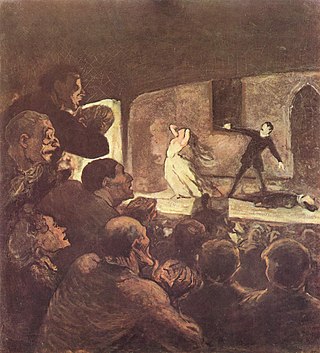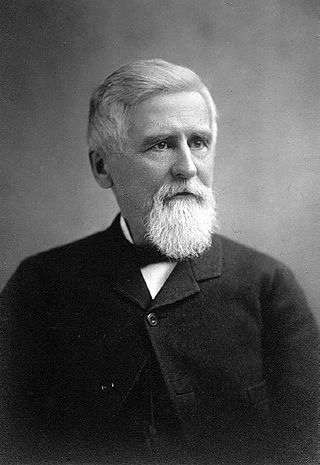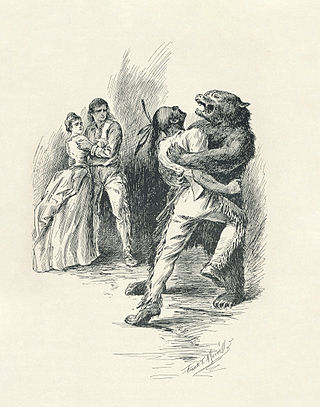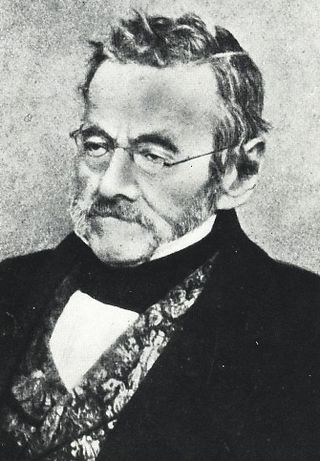
Gothic fiction, sometimes called Gothic horror in the 20th century, is a loose literary aesthetic of fear and haunting. The name is a reference to Gothic architecture of the European Middle Ages, which was characteristic of the settings of early Gothic novels.

American literature is literature written or produced in the United States of America and in the colonies that preceded it. The American literary tradition thus is part of the broader tradition of English-language literature, but also includes literature of other traditions produced in the United States and in other immigrant languages. Furthermore, a rich tradition of oral storytelling exists amongst Native American tribes.
This article contains information about the literary events and publications of 1854.

A modern melodrama is a dramatic work in which the plot, typically sensationalized and for a strong emotional appeal, takes precedence over detailed characterization. Melodramas typically concentrate on dialogue that is often bombastic or excessively sentimental, rather than action. Characters are often flat, and written to fulfill stereotypes. Melodramas are typically set in the private sphere of the home, focusing on morality and family issues, love, and marriage, often with challenges from an outside source, such as a "temptress", a scoundrel, or an aristocratic villain. A melodrama on stage, filmed, or on television is usually accompanied by dramatic and suggestive music that offers cues to the audience of the drama being presented.

Henry Charles Lea was an American publisher, civic activist, philanthropist and historian from Philadelphia, Pennsylvania.

The Last of the Mohicans: A Narrative of 1757 is an historical romance novel written by James Fenimore Cooper in 1826.

Robert Montgomery Bird was an American novelist, playwright, and physician.

Charles Sealsfield was the pseudonym of Austrian-American journalist CarlAnton Postl, an advocate for a German democracy. He lived in the United States from 1822 to 1826, and then again in 1828/1829. During a final stay from 1853 to 1858 he became a US citizen. Sealsfield is best known for his German-language Romantic novels with American backgrounds, and also wrote travelogues. He returned to Europe about 1829, living in Paris and London before settling in Switzerland in 1832, where he resided for most of the rest of his life.

Mathew Carey was an Irish-born American publisher and economist who lived and worked in Philadelphia, Pennsylvania. He was the father of economist Henry Charles Carey.

Nineteenth-century theatre describes a wide range of movements in the theatrical culture of Europe and the United States in the 19th century. In the West, they include Romanticism, melodrama, the well-made plays of Scribe and Sardou, the farces of Feydeau, the problem plays of Naturalism and Realism, Wagner's operatic Gesamtkunstwerk, Gilbert and Sullivan's plays and operas, Wilde's drawing-room comedies, Symbolism, and proto-Expressionism in the late works of August Strindberg and Henrik Ibsen.

The Bowery Theatre was a playhouse on the Bowery in the Lower East Side of Manhattan, New York City. Although it was founded by rich families to compete with the upscale Park Theatre, the Bowery saw its most successful period under the populist, pro-American management of Thomas Hamblin in the 1830s and 1840s. By the 1850s, the theatre came to cater to immigrant groups such as the Irish, Germans, and Chinese. It burned down four times in 17 years, a fire in 1929 destroying it for good. Although the theatre's name changed several times, it was generally referred to as the "Bowery Theatre".
Po-ca-hon-tas, or The Gentle Savage is a two-act musical burlesque by John Brougham (words) and James Gaspard Maeder (music). It debuted in 1855 and became an instant hit. Po-ca-hon-tas remained a staple of theatre troupes and blackface minstrel companies for the next 30 years, typically as an afterpiece.

Thomas Souness Hamblin was an English actor and theatre manager. He first took the stage in England, then immigrated to the United States in 1825. He received critical acclaim there, and eventually entered theatre management. During his tenure at New York City's Bowery Theatre he helped establish working-class theatre as a distinct form. His policies preferred American actors and playwrights to British ones, making him an important influence in the development of early American drama.
The Bowery Amphitheatre was a building in the Bowery neighborhood of New York City. It was located at 37 and 39 Bowery, across the street from the Bowery Theatre. Under a number of different names and managers, the structure served as a circus, menagerie, theatre, a roller rink, and a branch of the Peniel Mission. The site is now part of Confucius Plaza.
American gothic fiction is a subgenre of gothic fiction. Elements specific to American Gothic include: rationality versus the irrational, puritanism, guilt, the uncanny, ab-humans, ghosts, and monsters.

John Thomas Haines (c.1799–1843) was a British actor and dramatist.

Joseph Proctor was a popular 19th-century American actor. He was best known for playing the lead role in the melodrama Nick of the Woods.

American Gothic Press is an American comic book imprint of Famous Monsters of Filmland magazine. Established in the spring of 2015, it focuses predominantly on the kaiju, science fiction, fantasy and horror genres, reflecting the tastes of Honorary Famous Monsters Editor-in-Chief Forrest J Ackerman.
Louisa Medina (c.1813–1838), also known as Louisa Honore de Medina, Louisa Medina Hamblin, and the nickname Louisine, was a playwright and literary figure in New York City between the years 1833 and her death. She wrote poems, short stories, and approximately 34 melodramas of which only 11 remain extant. She is mostly known for adapting dramatic versions of Edward Bulwer-Lytton'sLast Days of Pompeii (1835) and Ernest Maltravers (1838), and Robert Montgomery Bird'sNick of the Woods (1838), among others. In an era when successful plays typically ran 3-4 nights, Last Days of Pompeii set a record by running for twenty-nine days. This was the earliest known example of a "long run" for a play, a technique which became regularly used by Thomas Hamblin. Medina is also accredited as the first women in American Theatre to earn her living exclusively as a dramatist. Louisa Medina's progressive inclinations concerning her education and self-reliance marks her as an indicator of the rise of First-Wave Feminism in America.

Logan, a Family History is a Gothic novel of historical fiction by American writer John Neal. Published anonymously in Baltimore in 1822, the book is inspired by the true story of Mingo leader Logan the Orator, but weaves a highly fictionalized story of interactions between Anglo-American colonists and Indigenous peoples on the western frontier of colonial Virginia. Set just before the Revolutionary War, it depicts the genocide of Native Americans as the heart of the American story and follows a long cast of characters connected to each other in a complex web of overlapping love interests, family relations, rape, and sexual activity.















